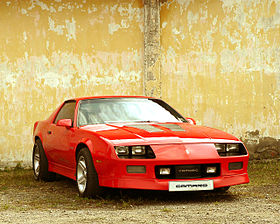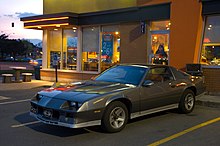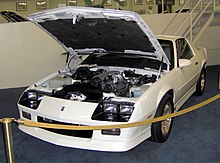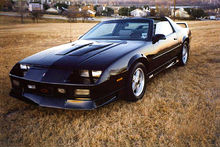Chevrolet Camaro (third generation)
| Chevrolet Camaro (third generation) | |
|---|---|
 | |
| Overview | |
| Manufacturer | General Motors |
| Production | 1982–1992 |
| Assembly |
|
| Body and chassis | |
| Class | |
| Body style |
|
| Layout | FR layout |
| Platform | F-body |
| Related | Pontiac Firebird |
| Powertrain | |
| Engine | |
| Transmission | |
| Dimensions | |
| Wheelbase | 2,565 mm (101.0 in)[1][2][3][4][5] |
| Length | 1982-1987: 4,877 mm (192.0 in)[1][2] 1988–1992: 4,890 mm (192.5 in)[3][4][5] |
| Width | 1,850 mm (72.8 in)[1][2][3][4][5] |
| Height | 1982-1987: 1,275 mm (50.2 in)[1][2] 1988–1990/1991-1992 Coupe: 1,280 mm (50.4 in)[3][4][5] 1991-1992 Convertible: 1,283 mm (50.5 in) |
| Curb weight | 1,400 kg (3,086.5 lb) - 1,525 kg (3,362.0 lb)[1][2][3][4][5] |
| Chronology | |
| Predecessor | Chevrolet Camaro (second generation) |
| Successor | Chevrolet Camaro (fourth generation) |
The third-generation Chevrolet Camaro was introduced for the 1982 model year. It continued to use General Motors's F-body platform and produced a "20th Anniversary Commemorative Edition" for 1987 and "25th Anniversary Heritage Edition" for 1992. These were also the first Camaros with factory fuel injection, four-speed automatic transmissions, five-speed manual transmissions, four-cylinder engines, 16-inch wheels, and hatchback bodies.[6] In 1987 a convertible Camaro was reintroduced, converted by ASC in relatively small numbers. The third-generation Camaro continued through the 1992 model year.
1983

The Camaro had a significant change in the Z28 engine lineup: the LU5 Crossfire 305 V8 was supplemented in April 1983 by an all-new 5.0 L L69 4 bbl 190 hp (142 kW) High-Output (HO) V8. This engine was only available with a manual transmission in 1983. Due to its late introduction, only 3,223 L69 V8s were sold for the 1983 model year.
Transmissions were upgraded for 1983. A Borg-Warner 5-speed manual transmission replaced the previous 4-speed. A 4-speed automatic transmission with overdrive replaced the 3-speed automatic transmission in the Z28. The TH700-R4 automatic overdrive was also available on the base coupe and Berlinetta, but was not available with the L69 H.O. engine in the Z28 for 1983.[7] Aside from the new transmissions, base coupe and Berlinetta carried on as in 1982 with very little change other than newly available colors.
1984
The new dashboard and controls were smaller with better quality and appearance. In the Berlinetta, the standard instrument cluster was replaced by electronic readouts, including a bar-graph tachometer and digital speedometer. The new dash came with an overhead console and pod-mounted controls for turn signals, cruise-control, HVAC, windshield wiper, and headlights. The radio was mounted inside a pod on the console that could swivel toward the driver or passenger.
Drivetrain changes included the discontinuation of the LU5 305 Cross Fire V8, and the addition of a hydraulic clutch linkage on manual transmission cars. The L69 H.O. Z28 became available with an automatic transmission for the first time.
The Z28's body and features remained mostly unchanged, except the fiberglass SMC hood was replaced with a steel version.
Road & Track selected the 1984 Camaro/Firebird as one of twelve best cars in the world and in the Best Sports GT category in the $11,000 to $14,000 range.[7] Car and Driver picked the 1984 Camaro Z28 as the best handling car built in the United States.[8]
1989

The 1989 model year signified the return of the RS designation (last used in 1987 on a limited edition California only model). The Rally Sport was now the base model featuring body ground effects mimicking the IROC and the previous Z28 but with the 2.8 V6 fuel-injected motor as standard with the 305 as an option. The raised rear spoiler that became available in 1988 on the base coupes was short-lived and done away with for this year.The engine ratings carried over from '88 with the addition of IROC-Z Coupes had a new dual catalytic converter exhaust option N10 that was standard with the G92 option only available on the 305 TPI motor with a manual transmission and the 350 TPI only available with the TH700-R4 automatic.
Power ratings also varied in the 305 from 170 hp (standard RPO L03) to 230 hp (RPO LB9 with manual transmission and dual exhaust) and boost to 240 hp for the 350 with dual exhaust.
IROC-Zs with the TPI 350 had the 2.77 rear axle ratio as in the previous year, but the optional RPO G92 Performance Axle package modified the ratio to 3.27 for the TPI 350, and 3.45 for the TPI 305 with manual transmission. RPO G92 also included the aforementioned dual-converter exhaust; 4-wheel disc brakes (RPO J65); engine oil cooler; P245/50ZR16 Goodyear Eagle unidirectional tires; a 145 mph (233 km/h) speedometer; and a tachometer with a 5,500 rpm redline. Only 1,426 IROC-Z coupes were equipped with the Performance Axle package in 1989.
To take an IROC-Z coupe to the maximum performance extreme in 1989, when G92 Performance Axle was ordered with no air conditioning (C41), RPO code 1LE was automatically triggered. This included extra equipment intended to make the IROC-Z more competitive in SCCA Showroom Stock road racing events: larger 11.65-inch (296 mm) rotors with 2-piston aluminium calipers from PBR; an aluminum driveshaft; a special baffled fuel tank; specific shock absorbers; and stiffer suspension bushings. The fog lamps were also deleted. Since the 1LE was simply an option combination, not a separate package or model which was promoted, very few customers or even Chevrolet dealers were aware of its existence. As a result, only 111 Camaros were built with the 1LE equipment in 1989.[7]
1990

The 1990 model year finished the lowest production to date (35,048), due to a truncated 1990 model run followed by the early introduction of the facelifted 1991 models. 1990 also marked the final year for the IROC-Z. Chevrolet had decided not to renew their contract with the International Race of Champions, which was later renewed by Chrysler's Dodge Daytona.
This year was the first year for an airbag to be offered in any F-body. The new airbag came alone with a new "half-moon" gauge cluster, that was offered only in 1990-1992 Camaros. The sharp edges on the dash surfaces were rounded. Lettering on gauges was yellow instead of white. 1990 was thus a distinguishable model year as it was the only 3rd gen Camaro that didn't feature the "aero" GFX but did have the newer interior/dash features. The 2.8 L V6 was upgraded to the 3.1 L V6.
The RPO code 1LE was again available in 1990, triggered as in the previous year by RPO G92 Performance Axle combined with no air conditioning on the IROC-Z coupe. Only 62 Camaros were built with 1LE equipment in 1990.[7]
Camaros in IROC-Z trim that were equipped with the 5.7 TPI Motor received a slight horsepower increase to 245 @ 4400 rpm and torque numbers also rose to 345 @ 3200 rpm.[9]
1991

Early in 1990, the 1991 Camaros debuted. Big changes occurred, as all Camaros received a facelift in the form of a ground effects package for both the RS and Z28 models, while the IROC-Z was no longer offered. The Z28 also featured a high rise spoiler and non-functional hood "blisters". The 1991 Z28 also received a new wheel design to accent the new body that the B4C "Special Service" option was made available to law enforcement, the government, and military agencies. The B4C amounted to little more than a Z28 powertrain and suspension in the RS. (Car Craft Magazine refers to the B4C as a 1LE equipped with air conditioning; although this is slightly erroneous because in 1991, the large brakes with PBR calipers from the 1LE package were not included with B4C.) Just under 600 B4C Camaros were sold for 1991. Power ratings on the 350 TPI were as follows; 245 hp (183 kW) at 4400 rpm and 340 lb⋅ft (461 N⋅m) at 3200 rpm. Power rating on the 305 TPI motor were as follows; 230 hp (172 kW) at 4200 rpm and 300 lb⋅ft (407 N⋅m) @3200 rpm. Rumors say that these numbers were slightly underrated by GM, but this has not been investigated.
Beginning with the 1991 model year, GM pioneered some modified assembly techniques with the F-body Camaro and Firebird which were carried forward into the fourth generation. Different seam sealers, structural adhesives and body assembly techniques were employed in key areas, in an effort to reduce squeaks and rattles and improve the perception of quality.
The SCCA Showroom-Stock-ready 1LE package continued with similar equipment to previous years, and was again triggered automatically by the G92 Performance Axle option combined with C41 basic ventilation system (no air conditioning) on the Z28 coupe. Enthusiasts and dealers were becoming more aware of the 1LE, as production increased to 478 units.[7]
1992

1992 was the final year of the third generation Camaro. A "25th Anniversary Heritage Edition" option had been planned with Corvette aluminum cylinder heads, tubular exhaust headers, and 6-speed manual transmission, but this was scrapped in favor of a "Heritage Package" option (RPO Z03) which amounted to nothing more than a graphics package of badges and rally stripes. All 1992 Camaros received a "25th Anniversary" badge on the dashboard. The 1992 version of the Camaro B4C (Special Service Package) got the addition of 1LE brakes, making it perhaps the best stopping third generation Camaro available with air conditioning. A total of 589 B4Cs were sold. The B4C option was also deemed popular enough to be carried on to the fourth generation model.
Some TPI 1992 Camaros received some of the "leftovers" from its Corvette cousin, which switched from Tuned Port Injection to the new LT1 engine series in 1992. They received the rough texture, cast aluminum style, intake runners from the TPI Corvette instead of the regular Camaro smooth tube ones. In some cases they were built with black painted valve covers instead of the normal silver valve covers. Some also received a blank throttlebody plate, like the LT1, instead of the normal plate with "Tuned Port Injection" script. The change was purely cosmetic, performance remained identical to the previous year.
The RPO 1LE option combination, identical to the previous year in specification and option requirements, had its highest production year of the third generation Camaro, with 705 cars so equipped. As mentioned, the 1LE brakes were included with B4C in 1992, accounting for 589 of the 705 built. This means that only 116 "true" 1LE-only cars (A/C delete, non-Special Service Package) were built for the year.[7]
It should be noted that the vast majority of the 1LE cars built during the 1989-1992 period were very sparsely equipped vehicles. Since they were intended for racing, where extra weight is a disadvantage and interiors are often gutted after purchase, most were very lightly optioned. The majority of 1LE Camaros had the base interior, with no power options, cruise control, or even floor mats. Some were even built without radios (201 cars were built as "radio delete" in 1992). An unusual Camaro equipped with a combination of both RPO 1LE and luxury or appearance options, such as a deluxe leather interior or the Z03 Heritage Package, could therefore be a potentially rare and collectible vehicle.
This was also the last year of production at the assembly plant in Van Nuys, California (and the United States as a whole). The last third-generation Camaro produced was a red Z28 coupe on August 27, 1992 that features signatures of the assembly line workers and is privately owned.[10]
Engines
- 1982–1985: 2.5 L (151 cid) LQ8 / LQ9 Iron Duke I4
- 1982–1984: 2.8 L (173 cid) LC1 V6
- 1985–1989: 2.8 L (173 cid) LB8 V6
- 1990–1992: 3.1 L (191 cid) LH0 V6
- 1982–1983: 5.0 L (305 cid) LU5 Small-Block V8
- 1982–1987: 5.0 L (305 cid) LG4 Small-Block V8
- 1983–1986: 5.0 L (305 cid) L69 Small-Block V8
- 1988–1992: 5.0 L (305 cid) LO3 Small-Block V8
- 1985–1992: 5.0 L (305 cid) LB9 Small-Block V8
- 1987–1992: 5.7 L (350 cid) L98 Small-Block V8
References
- ^ a b c d e "1986 CHEVROLET CAMARO IROC-Z DATA". Carfolio. Retrieved 2013-10-20.
- ^ a b c d e "1987 CHEVROLET CAMARO IROC-Z DATA". Carfolio. Retrieved 2013-10-20.
- ^ a b c d e "1988 CHEVROLET CAMARO DATA". Carfolio. Retrieved 2013-10-20.
- ^ a b c d e "1990 CHEVROLET CAMARO DATA". Carfolio. Retrieved 2013-10-20.
- ^ a b c d e "1991 CHEVROLET CAMARO Z28 DATA". Carfolio. Retrieved 2013-10-20.
- ^ "1982 Camaro". camaro3rdgen. Retrieved 2010-10-10.
- ^ a b c d e f Antonick, Mike (2004). The Camaro White Book. Motorbooks. ISBN 978-0-7603-1879-9.
- ^ Dunton, Pete (14 April 2012). "11984 Chevrolet Camaro Z28 L69 - Who Says You Can't Go Home Again?". Old Car Memories. Retrieved 19 December 2013.
- ^ http://www.prophetsofmadness.com/iroc-z/articles/articlepages/1990-2MotorTrendMagendofanera.htm
- ^ http://www.last1992camaro.com

